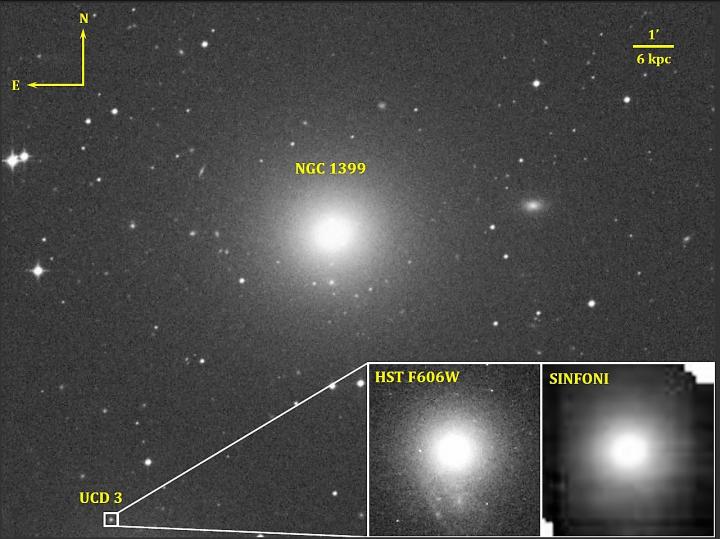MSU astronomers discovered supermassive black hole in an ultracompact dwarf galaxy

An optical image of the giant elliptical galaxy NGC 1399 and its satellite UCD3. Left panel: the image of UCD3 in F606W filter obtained by Hubble telescope. Right panel: an infrared image of UCD3 obtained using the SINFONI spectrograph. Courtesy of NASA/STScI/ESO/Afanasiev et al.
“We have discovered a supermassive black hole in the center of Fornax UCD3. The black hole mass is 3.5 million that of the Sun, similar to the central black hole in our own Milky Way” explained Anton Afanasiev, the first author of the article, a student of the department of the Faculty of Physics, MSU.
In the course of the study the scientists used the data collected with SINFONI, an infrared integral field spectrograph installed at one of the 8-m VLT telescopes in Chile operated by the European Southern Observatory.
Having analyzed the observed spectra, the authors derived the dependence between stellar velocity dispersion and radius in Fornax UCD3. Velocity dispersion quantifies the average variation between the individual stellar line-of-sight velocity and the mean velocity of the entire stellar population.
In the presence of a massive body such as a black hole the stars are influenced by its gravity and accelerate in various directions. Due to that their average speed does not grow but the dispersion increases considerably. This is the very effect that was observed in this galaxy: the velocity dispersion in its center is so high that it can only be explained by the presence of a massive central black hole.
After that the scientists compared the dependence of velocity and dispersion with dynamic models based on different assumptions of the black hole mass. They found that the model suggesting the mass of the black hole being equal to 3.5 million solar masses agreed with the observations best. They also considered the possibility that no black hole was present there at all, but that hypothesis was excluded with the statistical significance of (99.7%).
The black hole discovered by the authors is the fourth ever to be found in UCDs and corresponds to 4% of the total galaxy mass. In “normal” galaxies this ratio is considerably lower (about 0.3%). Despite there are few known examples, the existence of massive black holes in UCDs is a strong argument for the tidal origin of such galaxies.
According to this hypothesis, an average-sized galaxy passed a bigger and more massive one on a certain stage of its evolution and as a result of influence of tidal forces lost the majority of its stars. The remaining compact nucleus has become what we know as an ultracompact dwarf.
“To be able to say with complete assurance that this hypothesis is correct, we need to discover more supermassive black holes in UCDs. This is one of the prospects of this work.
Moreover, a similar methodology may be applied to more massive and less dense compact elliptical galaxies. In one of our next works we will study the population of central black holes in objects of this kind,” concluded the scientist.
###
The work was carried out in collaboration with the scientists from the European Southern Observatory (Germany and Chile), Max Planck Institute for Astronomy, Institute for Astrophysics Potsdam (Germany), University of Michigan, San Jose State University, Texas A&M University, University of Utah, University of California (USA), Australian Astronomical Observatory, Macquarie University, University of Queensland (Australia), as well as from Swiss Federal Institute of Technology Zurich.
Media Contact
All latest news from the category: Physics and Astronomy
This area deals with the fundamental laws and building blocks of nature and how they interact, the properties and the behavior of matter, and research into space and time and their structures.
innovations-report provides in-depth reports and articles on subjects such as astrophysics, laser technologies, nuclear, quantum, particle and solid-state physics, nanotechnologies, planetary research and findings (Mars, Venus) and developments related to the Hubble Telescope.
Newest articles

NASA: Mystery of life’s handedness deepens
The mystery of why life uses molecules with specific orientations has deepened with a NASA-funded discovery that RNA — a key molecule thought to have potentially held the instructions for…

What are the effects of historic lithium mining on water quality?
Study reveals low levels of common contaminants but high levels of other elements in waters associated with an abandoned lithium mine. Lithium ore and mining waste from a historic lithium…

Quantum-inspired design boosts efficiency of heat-to-electricity conversion
Rice engineers take unconventional route to improving thermophotovoltaic systems. Researchers at Rice University have found a new way to improve a key element of thermophotovoltaic (TPV) systems, which convert heat…



